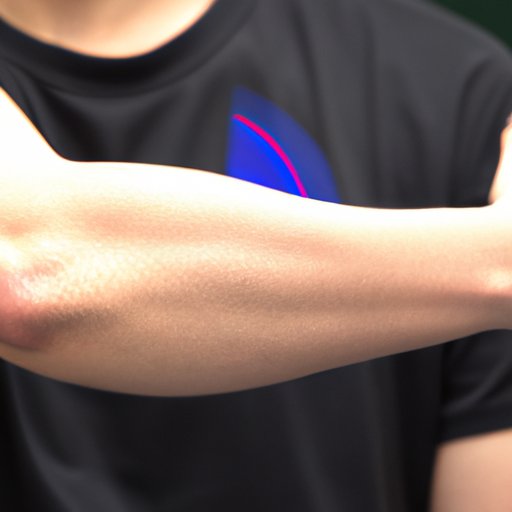Introduction
The rotator cuff is an important group of muscles and tendons in the shoulder that are responsible for movement and stability. When these structures become injured or torn, it can lead to significant pain and disability. This article will explore how to tell if you have torn your rotator cuff, as well as the diagnosis and treatment options available.
Definition of Rotator Cuff Injury
A rotator cuff injury is defined as damage to any of the four muscles and their associated tendons that make up the rotator cuff. These muscles are the supraspinatus, infraspinatus, teres minor, and subscapularis. The rotator cuff helps to move and stabilize the shoulder joint, and when it is damaged, it can lead to pain, weakness, and loss of range of motion (ROM).
Overview of Rotator Cuff Anatomy
The rotator cuff consists of four muscles and their associated tendons that attach to the humerus bone at the shoulder joint. The muscles and tendons provide stability and allow for specific movements of the shoulder joint. The tendons of the rotator cuff pass through a small space between the humerus and the acromion, which is the bony projection from the shoulder blade. This space, known as the subacromial space, can become narrowed due to inflammation or injury, leading to impingement of the rotator cuff tendons.

Identifying Symptoms of a Rotator Cuff Tear
If you think you may have torn your rotator cuff, there are several symptoms that can indicate a tear. These include:
- Pain in the Shoulder: Pain is the most common symptom of a rotator cuff tear. It may be felt in the front, side, or back of the shoulder, and may worsen with certain activities or when the arm is lifted overhead.
- Weakness in the Arm or Hand: Weakness in the affected arm or hand can also be a sign of a rotator cuff tear. It may be difficult to lift or move the arm, and doing so may cause pain.
- Loss of Range of Motion: A decrease in ROM can also be an indication of a rotator cuff tear. You may not be able to lift your arm as high as usual or reach behind your back.

Diagnosis and Treatment Options for a Rotator Cuff Injury
If you think you may have torn your rotator cuff, it is important to seek medical attention as soon as possible. Your doctor will perform a physical examination to assess your shoulder strength and range of motion. They may also order imaging tests such as an X-ray, MRI, or CT scan to confirm the diagnosis.
Once the diagnosis is confirmed, your doctor will discuss treatment options with you. Non-surgical treatments such as rest, ice, and anti-inflammatory medications may be recommended to reduce pain and swelling. Physical therapy is also often recommended to help improve strength and ROM. If these treatments are not successful, surgery may be necessary to repair the tear.

Understanding the Anatomy of the Rotator Cuff
In order to understand the anatomy of the rotator cuff, it is important to understand the structures that make up the shoulder joint. The shoulder joint is made up of three bones: the humerus, scapula, and clavicle. The rotator cuff is composed of four muscles and their associated tendons: the supraspinatus, infraspinatus, teres minor, and subscapularis.
These muscles and tendons attach to the humerus bone at the shoulder joint and provide stability and movement. The muscles and tendons pass through a small space between the humerus and the acromion, which is the bony projection from the shoulder blade. This space, known as the subacromial space, can become narrowed due to inflammation or injury, leading to impingement of the rotator cuff tendons.

Exploring Physical Therapy Techniques to Strengthen the Shoulder
Physical therapy can be an effective way to manage a rotator cuff injury and restore strength and mobility in the shoulder. Stretching exercises can help to improve flexibility and ROM, while strengthening exercises can help to build muscle strength and endurance. Some of the most commonly used strengthening exercises for the rotator cuff include shoulder presses, internal and external rotation exercises, and lateral raises.
It is important to work with a physical therapist who can guide you through the exercises and ensure that you are using proper form. This will help to prevent further injury and ensure that you are getting the most benefit from the exercises.
Using Imaging Tests to Confirm a Rotator Cuff Tear
Imaging tests such as X-rays, MRIs, and CT scans can be used to confirm a rotator cuff tear. X-rays can be used to look for fractures and other abnormalities, while MRIs and CT scans can provide detailed images of the soft tissues of the shoulder. These tests can help doctors confirm the diagnosis of a rotator cuff tear and determine the extent of the injury.
Conclusion
Rotator cuff tears can be painful and disabling, but with early diagnosis and treatment, they can be managed effectively. Understanding the anatomy of the rotator cuff and being aware of the signs and symptoms of a tear can help you identify a potential injury and get the treatment you need. Working with a physical therapist to develop a personalized exercise program can help to strengthen the shoulder and reduce pain and disability.
(Note: Is this article not meeting your expectations? Do you have knowledge or insights to share? Unlock new opportunities and expand your reach by joining our authors team. Click Registration to join us and share your expertise with our readers.)
